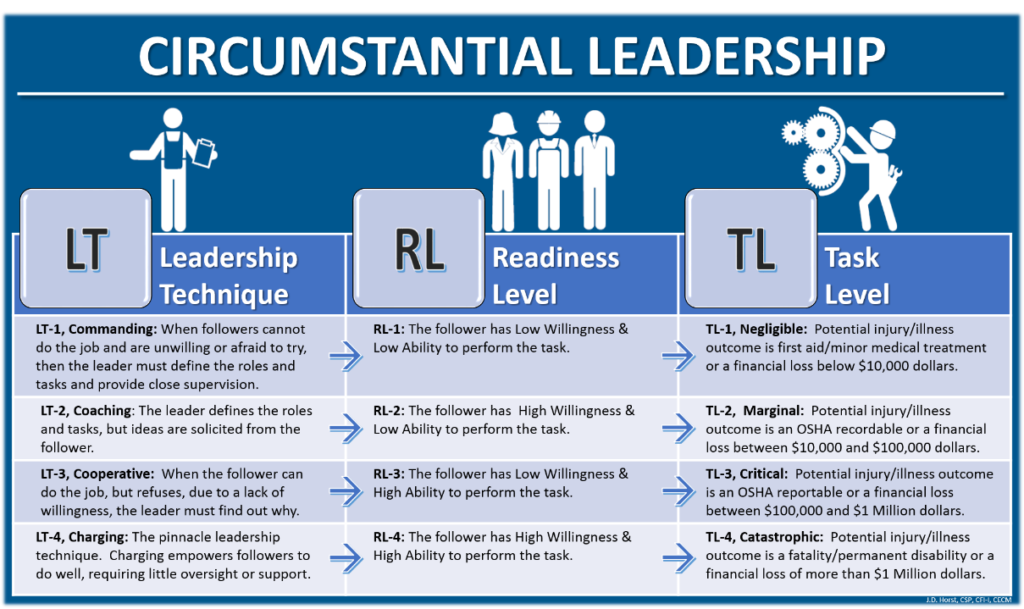Whether you are dealing with subordinates, supervisors, volunteers, or the public, leadership skills are necessary. Leadership involves vision, direction, coordination, and motivation toward achieving desired goals. While it takes time to develop these skills, the ability to lead people and accomplish tasks is a core competency needed by all environment, health, and safety (EHS) professionals.
Every element of your occupational safety and health management program requires some measure of circumstantial leadership. There is no one-size-fits-all approach—circumstances, task level, and personnel readiness dictate the appropriate leadership technique to be used. When applying circumstantial leadership, no one person or task receives the same technique but rather an individualized technique tailored to the individual’s readiness and/or the potential outcome of the task.
As a leader, you must evaluate, formulate, execute, and follow up. Here are three keys to effectively implement a circumstantial leadership model.
Readiness Level
Let’s look first at the persons you are leading—we’ll refer to them as individual followers—and their ability and willingness as they relate to the assigned task. This readiness level (RL) will determine the most appropriate leadership technique. It is important that you consider the task and the person every time; even though you may have a follower who has a high willingness and high ability on 98% of the tasks, don’t set the person up for failure on the 2% that requires different circumstantial leadership techniques.
When assigning work to individual followers, you must consider their RL based on a combination of ability and willingness. When evaluating an individual’s ability, make sure you gauge both transferable technical skills and soft skills. These skills may be apparent through prior demonstration, personal aptitude, and/or your perception. Determining an individual’s willingness requires you to evaluate his or her confidence and determination toward the task. The four RLs are:
- RL-1: Low Willingness and Low Ability
- RL-2: High Willingness and Low Ability
- RL-3: Low Willingness and High Ability
- RL-4: High Willingness and High Ability
Leadership Technique
The leadership technique (LT) you choose to employ is contingent on the combination of willingness and ability levels described above. LTs are broken down into four levels and are easily paired to the readiness levels through a numerical match (i.e., LT-1 pairs with RL-1). The four “C’s” of circumstantial leadership techniques are identified and defined below.
- LT-1, Commanding: This leadership technique is most appropriate when the followers have low willingness and low ability for the task at hand. When followers cannot do the job and are unwilling or afraid to try, then the leader must define the roles/tasks and provide close supervision. Commanding is often used when the issue is serious or an unfavorable outcome would result in drastic consequences. The leader maintains a commanding position to ensure all activities are accomplished. Decisions are made solely by the leader.
- LT-2, Coaching: This technique is appropriate when followers have high willingness but low ability for the task at hand. Coaching requires the leader to define the roles and tasks, but ideas are solicited from the followers. Followers require a coaching technique because they are relatively inexperienced and need support and praise to build their confidence. While coaching, the leader spends time listening, advising, and helping followers gain necessary skills so that they can be provided with more autonomy in the future.
- LT-3, Cooperative: When followers have low willingness but high ability for the task at hand, use the cooperative leadership technique. When followers can do the job but refuse due to a lack of willingness, the leader must find out why and persuade them to cooperate. The key to this technique is motivating and building confidence in them. Cooperative leadership involves listening, giving praise, and making followers feel good.
- LT-4, Charging: This is considered the pinnacle leadership technique. As followers develop a high willingness and high ability to accomplish tasks, this technique will aid in multiplying productivity and success. Charging empowers followers to do well, and they require little oversight or support. As the leader, you are still involved in evaluating and formulating decisions, but execution is in the hands of the followers. Because the followers are charged with control, they are responsible for communicating information back up to the leader.
Task Level
When sizing up the circumstances and evaluating individual readiness, don’t forget to consider the task level (TL) and potential outcome. The higher the outcome severity, the more cautious you must be as a leader to hand the task off to a follower. Again, this component of circumstantial leadership has been broken down into four techniques, as follows:
- TL-1, Negligible: The potential injury/illness outcome is first-aid/minor medical treatment or a financial loss below $10,000.
- TL-2, Marginal: The potential injury/illness outcome is an Occupational Safety and Health Administration (OSHA) recordable or a financial loss between $10,000 and $100,000.
- TL-3, Critical: The potential injury/illness outcome is an OSHA reportable or a financial loss between $100,000 and $1 million.
- TL-4, Catastrophic: The potential injury/illness outcome is a fatality or permanent total disability or a financial loss of more than $1 million.
When applied properly, leading your subordinates and/or other operational units utilizing this circumstantial leadership tool will result in successful outcomes. To ensure your success, make certain you do not mismatch the leadership technique to the wrong RL and/or TL. For example, if you pair LT-1 with RL-4 or TL-4, you provide over-supervision—in this mismatch, the follower is going to resent your technique and wonder why you are micromanaging; plus, you are depleting individual resources that should be focused on more serious circumstances. Another mismatch is pairing an RL-1 or a TL-1 with an LT-4—in this scenario, the individual follower and his or her task is set up for failure because there is little to no oversight by the leader.

Another key to success is communicating with individual followers so they know what to expect from you as the leader. Poor communication and lack of honest feedback from all parties involved will certainly lead to an overall failure, a lack of trust, and the insufficient completion of tasks. As a leader, you must ensure that you are teaching, listening, encouraging, praising, providing feedback, and facilitating independent problem-solving; additionally, you should be employing these different leadership skills at the right time, during the right circumstance, and for the right reason. With the circumstantial leadership tool, you can strike this balance while avoiding a one-size-fits-all approach in leading people and tasks.
 J.D. Horst, CSP, CSHO, CFI-I, LEAN6σ, is the Interim Occupational Safety Manager at Argonne National Laboratory. Find him on LinkedIn at https://www.linkedin.com/in/jd-horst/. J.D. Horst, CSP, CSHO, CFI-I, LEAN6σ, is the Interim Occupational Safety Manager at Argonne National Laboratory. Find him on LinkedIn at https://www.linkedin.com/in/jd-horst/. |

